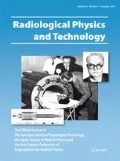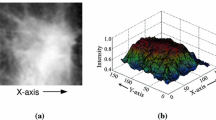Abstract
In this study, we developed an automatic extraction scheme for the precise recognition of the contours of masses on digital mammograms in order to improve a computer-aided diagnosis (CAD) system. We propose a radial-searching contour extraction method based on a modified active contour model (ACM). In this technique, after determining the central point of a mass by searching for the direction of the density gradient, we arranged an initial contour at the central point, and the movement of a control point was limited to directions radiating from the central point. Moreover, it became possible to increase the extraction accuracy by sorting out the pixel used for processing and using two images—an edge-intensity image and a degree-of-separation image defined based on the pixel-value histogram—for calculation of the image forces used for constraints on deformation of the ACM. We investigated the accuracy of the automated extraction method by using 53 masses with several “difficult contours” on 53 digitized mammograms. The extraction results were compared quantitatively with the “correct segmentation” represented by an experienced physician’s sketches. The numbers of cases in which the extracted region corresponded to the correct region with overlap ratios of more than 81 and 61% were 30 and 45, respectively. The initial results obtained with this technique show that it will be useful for the segmentation of masses in CAD schemes.










Similar content being viewed by others
References
Hologic, Inc., R2 ImageChecker®, http://www.r2tech.com/.
iCAD, Inc., SecondLook®, http://www.icadmed.com.
Eastman Kodak Company. Kodak Mammography Computer-Aided Detection System, http://www.Kodak.com.
Matsubara T, Fujita H, Hara T, Kasai S, Otsuka O, Hatanaka Y, et al. New algorithm for mass detection in digital mammograms. Proceedings of CARS (Computer Assisted Radiology and Surgery) ‘98. 1998; International Congress Series 1165:219–23.
Hatanaka Y, Hara T, Fujita H, Kasai S, Endo T, Iwase T. Development of an automated method for detecting mammographic masses with a partial loss of region. IEEE Trans Med Imag. 2001;20:1209–14.
Matsubara T, Ichikawa T, Hara T, Fujita H, Kasai S, Endo T, et al. Automated detection methods for architectural distortions around skinline and within mammary gland on mammograms. Proceedings of CARS (Computer Assisted Radiology and Surgery) 2003. 2003; International Congress Series 1256:950–5.
Ibrahim N, Fujita H, Hara T, Endo T. Automated detection of clustered microcalcifications on mammograms: CAD system application to MIAS database. Phys Med Biol. 1997;42:2577–89.
Nakagawa T, Hara T, Fujita H, Iwase T, Endo T. Image retrieval scheme for mammographic masses by using a local pattern matching technique. Proceedings of CARS (Computer Assisted Radiology and Surgery) 2002. 2002;665–70.
Li HD, Kallergi M, Clarke LP, Jain VK, Clark RA. Markov random field for tumor detection in digital mammography. IEEE Trans Med Imag. 1995;14:565–76.
Petrick N, Chan HP, Wei D, Sahiner B, Helvie MA, Adler DD. Automated detection of breast masses on mammograms using adaptive contrast enhancement and texture classification. Med Phys. 1996;23:1685–96.
Kupinski MA, Giger ML. Automated seeded lesion segmentation on digital mammograms. IEEE Trans Med Imag. 1998;17:510–7.
Brake GM, Karssemeijer N. Segmentation of suspicious densities in digital mammograms. Med Phys. 2001;28:259–66.
Li H, Wang Y, Liu KJ, Lo SC, Freedman MT. Computerized radiographic mass detection—part I: lesion site selection by morphological enhancement and contextual segmentation. IEEE Trans Med Imag. 2001;20:289–301.
Sahiner B, Petrick N, Chan HP, Hadjiiski LM, Paramagul C, Helvie MA, et al. Computer-aided characterization of mammographic masses: accuracy of mass segmentation and its effects on characterization. IEEE Trans Med Imag. 2001;20:1275–84.
Timp S, Karssemeijer N. A new 2D segmentation method based on dynamic programming applied to computer aided detection in mammography. Med Phys. 2004;31:958–71.
Kass M, Witikin A, Terzopoulos D. Snakes: active contour models. Int J Comput Vis. 1987;1:321–31.
Serra J. Introduction to mathematical morphology. Comput Vis Graphics Image Process. 1986;35:283–305.
Sternberg SR. Grayscale morphology. Comput Vis Graphics Image Process. 1986;35:333–55.
Parker JR. Algorithms for image processing and computer vision. New York: Wiley Computer Publishing 1997.
Otsu N. A threshold selection method from gray-level histograms. IEEE Trans Syst Man Cybern. 1979;SMC-9:62–6.
Nakagawa T, Sakurai H, Hara T, Fujita H, Iwase T, Endo T, et al. Development of automatic classification system for mammographic masses: saw-tooth region detection method for recognition of mass contour shapes (Japanese). Trans Jpn Soc Med Biol Eng. 2005;43:437–46.
Acknowledgments
This study was supported in part by a Grant-in-Aid for Scientific Research from the Japan Society for the Promotion of Science, a Grant-in-Aid for Cancer Research from the Ministry of Health, Labour and Welfare, Japan, and a grant for the “Intellectual Cluster Creation Project” from the Ministry of Education, Culture, Sports, Science and Technology, Japan. We are grateful to reviewers for their helpful comments and suggestions, and the Editorial Assistant for providing detailed suggestions for improving this manuscript.
Author information
Authors and Affiliations
Corresponding author
About this article
Cite this article
Nakagawa, T., Hara, T., Fujita, H. et al. Radial-searching contour extraction method based on a modified active contour model for mammographic masses. Radiol Phys Technol 1, 151–161 (2008). https://doi.org/10.1007/s12194-008-0022-5
Received:
Revised:
Accepted:
Published:
Issue Date:
DOI: https://doi.org/10.1007/s12194-008-0022-5




